Siemens 20 3000, 20 2000, 20 5000, 20 ME User Manual
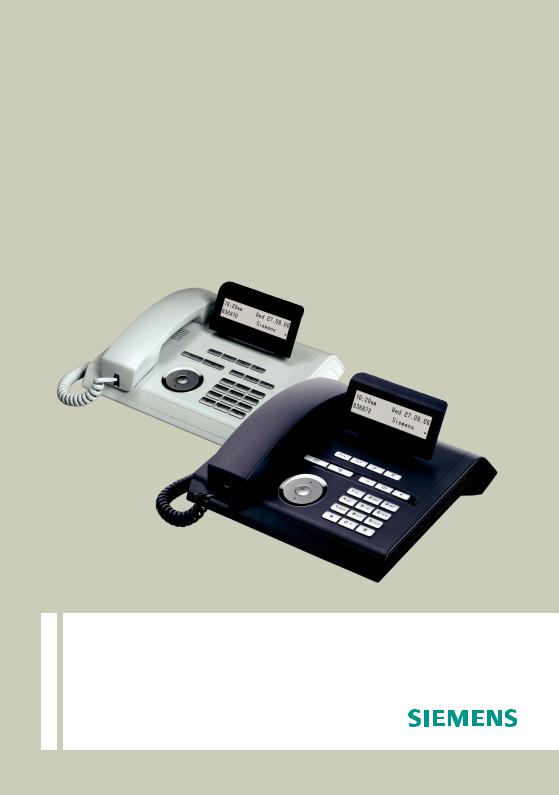
Documentation
HiPath 2000, HiPath 3000, HiPath 5000
HiPath OpenOffice ME
OpenStage 20
Operating Instructions
Communication for the open minded
Siemens Enterprise Communications www.siemens.com/open
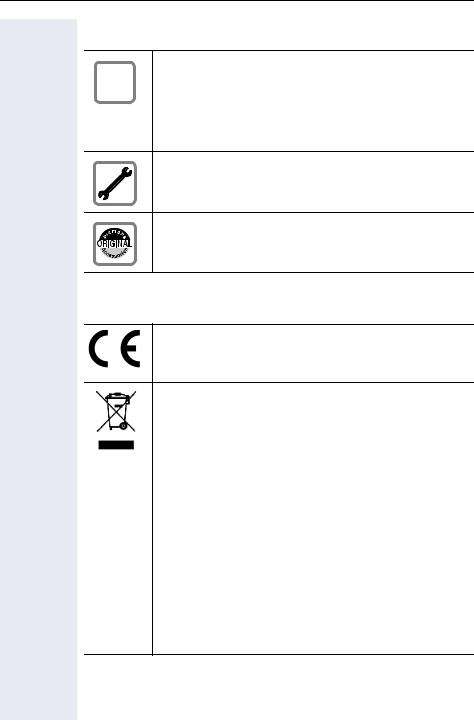
Important information
Important information
For safety reasons, the telephone should only be supplied
Qwith power:
•using the original power supply unit.
Part number: C39280-Z4-C51x (x: 0=EU, 1=US, 2=UK) or
•in a LAN with PoE (Power over Ethernet), which complies with the IEEE 802.3af standard.
Never open the telephone or a key module. Should you encounter any problems, contact the responsible service personnel.
Use only original Siemens accessories. The use of other accessories may be hazardous and will render the warranty, extended manufacturer’s liability and the CE marking invalid.
Trademarks
The device conforms to the EU directive 1999/5/EC as attested by the CE marking.
All electrical and electronic products should be disposed of separately from the municipal waste stream via designated collection facilities appointed by the government or the local authorities.
Proper disposal and separate collection of your old appliance will help prevent potential damage to the environment and human health. It is a prerequisite for reuse and recycling of used electrical and electronic equipment.
For more detailed information about disposal of your old appliance, please contact your city office, waste disposal service, the shop where you purchased the product or your sales representative.
The statements quoted above are only fully valid for equipment which is installed and sold in the countries of the European Union and is covered by the directive 2002/96/EC.
Countries outside the European Union may impose other regulations regarding the disposal of electrical and electronic equipment.
2
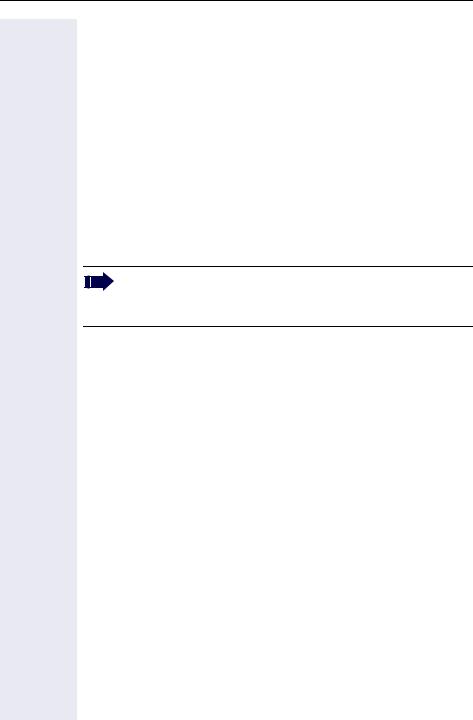
Important information
Location of the telephone
•The telephone should be operated in a controlled environment with an ambient temperature between 5°C and 40°C.
•To ensure good speakerphone quality, the area in front of the microphone (front right) should be kept clear. The optimum speakerphone distance is 50 cm.
•Do not install the telephone in a room where large quantities of dust accumulate; this can considerably reduce the service life of the telephone.
•Do not expose the telephone to direct sunlight or any other source of heat, as this is liable to damage the electronic components and the plastic casing.
•Do not operate the telephone in damp environments such as bathrooms.
Software update
During a software update, the phone must not be disconnected from the power supply unit, the LAN line or the phone line.
An update action is indicated by messages on the display and/or by flashing LEDs.
Documentation in Internet
This and other documentation can be found on the Internet at: http://www.enterprise-communications.siemens.com > Products > Phones & Clients > (Select Product) > Downloads.
To view and print documentation in PDF format, you require Acrobat Reader (free software):
http://www.adobe.com
Technical notes, current information about firmware updates, frequently asked questions and lots more can be found on the web at: http://wiki.siemens-enterprise.com/
3

Contents
Contents
Important information . . . . . . . . . . . . . . . . . . . . . . . . . .2
Trademarks . . . . . . . . . . . . . . . . . . . . . . . . . . . . . . . . . . . . . . . . . . . . . . . 2 Location of the telephone . . . . . . . . . . . . . . . . . . . . . . . . . . . . . . . . . . . . 3 Software update . . . . . . . . . . . . . . . . . . . . . . . . . . . . . . . . . . . . . . . . . . . 3 Documentation in Internet. . . . . . . . . . . . . . . . . . . . . . . . . . . . . . . . . . . . 3
General information. . . . . . . . . . . . . . . . . . . . . . . . . . . .8
About this manual . . . . . . . . . . . . . . . . . . . . . . . . . . . . . . . . . . . . . . . . . . 8 Service. . . . . . . . . . . . . . . . . . . . . . . . . . . . . . . . . . . . . . . . . . . . . . . . . . . 8 Intended use . . . . . . . . . . . . . . . . . . . . . . . . . . . . . . . . . . . . . . . . . . . . . . 9 Telephone type . . . . . . . . . . . . . . . . . . . . . . . . . . . . . . . . . . . . . . . . . . . . 9 Speakerphone quality and display legibility . . . . . . . . . . . . . . . . . . . . . . . 9
Getting to know your OpenStage phone . . . . . . . . .10
OpenStage 20 user interface. . . . . . . . . . . . . . . . . . . . . . . . . . . . . . . . . 10 Ports on the underside of the phone. . . . . . . . . . . . . . . . . . . . . . . . . . . 11 Using network ports more efficiently . . . . . . . . . . . . . . . . . . . . . . . 12 Keys. . . . . . . . . . . . . . . . . . . . . . . . . . . . . . . . . . . . . . . . . . . . . . . . . . . . 13 Function keys. . . . . . . . . . . . . . . . . . . . . . . . . . . . . . . . . . . . . . . . . . 13 Mailbox key and Menu key . . . . . . . . . . . . . . . . . . . . . . . . . . . . . . . 13 Audio keys . . . . . . . . . . . . . . . . . . . . . . . . . . . . . . . . . . . . . . . . . . . . 13 3-way navigator . . . . . . . . . . . . . . . . . . . . . . . . . . . . . . . . . . . . . . . . 14 Keypad . . . . . . . . . . . . . . . . . . . . . . . . . . . . . . . . . . . . . . . . . . . . . . . 15 Display. . . . . . . . . . . . . . . . . . . . . . . . . . . . . . . . . . . . . . . . . . . . . . . . . . 16 Idle mode. . . . . . . . . . . . . . . . . . . . . . . . . . . . . . . . . . . . . . . . . . . . . 16 Mailbox . . . . . . . . . . . . . . . . . . . . . . . . . . . . . . . . . . . . . . . . . . . . . . . . . 17 Messages . . . . . . . . . . . . . . . . . . . . . . . . . . . . . . . . . . . . . . . . . . . . 17 Voicemail . . . . . . . . . . . . . . . . . . . . . . . . . . . . . . . . . . . . . . . . . . . . . 17 Caller list . . . . . . . . . . . . . . . . . . . . . . . . . . . . . . . . . . . . . . . . . . . . . . . . 18 Program/Service menu . . . . . . . . . . . . . . . . . . . . . . . . . . . . . . . . . . . . . 19
Basic functions. . . . . . . . . . . . . . . . . . . . . . . . . . . . . . .20
Answering a call . . . . . . . . . . . . . . . . . . . . . . . . . . . . . . . . . . . . . . . . . . 20 Answering a call via the handset . . . . . . . . . . . . . . . . . . . . . . . . . . . 20 Answering a call via the loudspeaker (speakerphone mode). . . . . . 21 Switching to speakerphone mode. . . . . . . . . . . . . . . . . . . . . . . . . . . . . 21 Switching to the handset. . . . . . . . . . . . . . . . . . . . . . . . . . . . . . . . . . . . 22 Open listening in the room during a call . . . . . . . . . . . . . . . . . . . . . . . . 22 Making calls. . . . . . . . . . . . . . . . . . . . . . . . . . . . . . . . . . . . . . . . . . . . . . 23 Off-hook dialing . . . . . . . . . . . . . . . . . . . . . . . . . . . . . . . . . . . . . . . . 23 On-hook dialing . . . . . . . . . . . . . . . . . . . . . . . . . . . . . . . . . . . . . . . . 23
4

Contents
Redialing a number . . . . . . . . . . . . . . . . . . . . . . . . . . . . . . . . . . . . . . . . 24 Ending a call. . . . . . . . . . . . . . . . . . . . . . . . . . . . . . . . . . . . . . . . . . . . . . 24 Rejecting calls . . . . . . . . . . . . . . . . . . . . . . . . . . . . . . . . . . . . . . . . . . . . 25 Turning the microphone on and off . . . . . . . . . . . . . . . . . . . . . . . . . . . . 25 Calling a second party (consultation) . . . . . . . . . . . . . . . . . . . . . . . . . . . 26
Switching to the held party (alternating) . . . . . . . . . . . . . . . . . . . . . 26 Transferring a call. . . . . . . . . . . . . . . . . . . . . . . . . . . . . . . . . . . . . . . 27 Call forwarding. . . . . . . . . . . . . . . . . . . . . . . . . . . . . . . . . . . . . . . . . . . . 28 Using variable call forwarding . . . . . . . . . . . . . . . . . . . . . . . . . . . . . 28 Using call forwarding no reply (CFNR) . . . . . . . . . . . . . . . . . . . . . . . 29 Call forwarding in the event of telephone failure (CFSS) . . . . . . . . . 30
Call forwarding in the carrier network and
forwarding multiple subscriber numbers (MSN) (not for U.S.). . . . . 31 Using callback . . . . . . . . . . . . . . . . . . . . . . . . . . . . . . . . . . . . . . . . . . . . 32 Storing a callback . . . . . . . . . . . . . . . . . . . . . . . . . . . . . . . . . . . . . . . 32 Accepting a callback. . . . . . . . . . . . . . . . . . . . . . . . . . . . . . . . . . . . . 32 Viewing and deleting a stored callback . . . . . . . . . . . . . . . . . . . . . . 33
Enhanced phone functions . . . . . . . . . . . . . . . . . . . . 34
Answering calls . . . . . . . . . . . . . . . . . . . . . . . . . . . . . . . . . . . . . . . . . . . 34 Accepting a specific call for your colleague . . . . . . . . . . . . . . . . . . . 34 Using the speakerphone . . . . . . . . . . . . . . . . . . . . . . . . . . . . . . . . . 35 Answering calls from the entrance telephone and opening the door36 Making calls. . . . . . . . . . . . . . . . . . . . . . . . . . . . . . . . . . . . . . . . . . . . . . 38 En-bloc sending/correcting numbers . . . . . . . . . . . . . . . . . . . . . . . . 38 Using the caller list. . . . . . . . . . . . . . . . . . . . . . . . . . . . . . . . . . . . . . 39 Dialing a number from the internal directory . . . . . . . . . . . . . . . . . . 40 Dialing from the telephone database (LDAP) . . . . . . . . . . . . . . . . . 41 Making calls using system speed-dial numbers . . . . . . . . . . . . . . . 43 Dialing with speed-dial keys . . . . . . . . . . . . . . . . . . . . . . . . . . . . . . 43 Talking to your colleague with a speaker call. . . . . . . . . . . . . . . . . . 44 Talking to your colleague with discreet calling. . . . . . . . . . . . . . . . . 45 Automatic connection setup (hotline) . . . . . . . . . . . . . . . . . . . . . . . 45 Assigning a station number (not for U.S.) . . . . . . . . . . . . . . . . . . . . 45 Associated dialing/dialing aid . . . . . . . . . . . . . . . . . . . . . . . . . . . . . . 46 During a call . . . . . . . . . . . . . . . . . . . . . . . . . . . . . . . . . . . . . . . . . . . . . . 47 Using call waiting (second call) . . . . . . . . . . . . . . . . . . . . . . . . . . . . 47 Preventing and allowing call waiting (automatic camp-on) . . . . . . . 48 Turning the call waiting tone on and off. . . . . . . . . . . . . . . . . . . . . . 48 Saving a number . . . . . . . . . . . . . . . . . . . . . . . . . . . . . . . . . . . . . . . 48 Parking a call . . . . . . . . . . . . . . . . . . . . . . . . . . . . . . . . . . . . . . . . . . 49 Conducting a conference . . . . . . . . . . . . . . . . . . . . . . . . . . . . . . . . . 50 Activating tone dialing/DTMF suffix-dialing . . . . . . . . . . . . . . . . . . . 52 Transferring a call after a speaker call announcement in a group . . 53 Send trunk flash . . . . . . . . . . . . . . . . . . . . . . . . . . . . . . . . . . . . . . . 54
5

Contents
If you cannot reach a destination. . . . . . . . . . . . . . . . . . . . . . . . . . . . . . 55 Call waiting (camp-on) . . . . . . . . . . . . . . . . . . . . . . . . . . . . . . . . . . . 55 Busy override - joining a call in progress . . . . . . . . . . . . . . . . . . . . . 55 Using night answer . . . . . . . . . . . . . . . . . . . . . . . . . . . . . . . . . . . . . . . . 56
Displaying and assigning call charges . . . . . . . . . .57
Displaying call charges (not for U.S.) . . . . . . . . . . . . . . . . . . . . . . . . . . . 57 Dialing with call charge assignment . . . . . . . . . . . . . . . . . . . . . . . . . . . 58
Privacy/security . . . . . . . . . . . . . . . . . . . . . . . . . . . . . .59
Turning ringer cutoff on and off. . . . . . . . . . . . . . . . . . . . . . . . . . . . . . . 59 Activating/deactivating "Do not disturb". . . . . . . . . . . . . . . . . . . . . . . . . 59 Caller ID suppression. . . . . . . . . . . . . . . . . . . . . . . . . . . . . . . . . . . . . . . 60 Monitoring a room . . . . . . . . . . . . . . . . . . . . . . . . . . . . . . . . . . . . . . . . . 61 Trace call: identifying anonymous callers (not for U.S.). . . . . . . . . . . . . 62 Locking the telephone to prevent unauthorized use . . . . . . . . . . . . . . . 63 Locking another telephone to prevent unauthorized use . . . . . . . . . . . 64 Saving your PIN . . . . . . . . . . . . . . . . . . . . . . . . . . . . . . . . . . . . . . . . . . . 65
More functions/services. . . . . . . . . . . . . . . . . . . . . . .66
Appointments function . . . . . . . . . . . . . . . . . . . . . . . . . . . . . . . . . . . . . 66 Saving appointments . . . . . . . . . . . . . . . . . . . . . . . . . . . . . . . . . . . . 66 Using timed reminders . . . . . . . . . . . . . . . . . . . . . . . . . . . . . . . . . . 67 Sending a message . . . . . . . . . . . . . . . . . . . . . . . . . . . . . . . . . . . . . . . . 67 Creating and sending a message. . . . . . . . . . . . . . . . . . . . . . . . . . . 67 Viewing and editing incoming messages. . . . . . . . . . . . . . . . . . . . . 68 Leaving an advisory message . . . . . . . . . . . . . . . . . . . . . . . . . . . . . . . . 69 Deleting advisory messages . . . . . . . . . . . . . . . . . . . . . . . . . . . . . . 69 Using another telephone like your own for a call . . . . . . . . . . . . . . . . . 70
Resetting services and functions
(system-wide cancellation for a telephone) . . . . . . . . . . . . . . . . . . . . . . 71 Activating functions for another telephone . . . . . . . . . . . . . . . . . . . . . . 72 Using system functions from outside
(DISA: Direct Inward System Access) . . . . . . . . . . . . . . . . . . . . . . . . . . 73 Using functions in ISDN via code dialing (keypad dialing) . . . . . . . . . . . 74 Controlling connected computers or programs running on them/telephone data services . . . . . . . . . . . . . . . . . . . . . . . . . . . . . . . . . . . . . . . . . . . . . 75 Communicating with PC applications over a CSTA interface . . . . . . . . 76 Controlling relays
(only for HiPath 3000) . . . . . . . . . . . . . . . . . . . . . . . . . . . . . . . . . . . . . . 77 Sensors (HiPath 33x0/35x0 only). . . . . . . . . . . . . . . . . . . . . . . . . . . . . . 77 Radio paging (not for U.S.). . . . . . . . . . . . . . . . . . . . . . . . . . . . . . . . . . . 78
6

Contents
Using team functions . . . . . . . . . . . . . . . . . . . . . . . . . 79
Activating/deactivating a group call . . . . . . . . . . . . . . . . . . . . . . . . . . . . 79 Accepting a call for another member of your team . . . . . . . . . . . . . . . . 81 Ringing group . . . . . . . . . . . . . . . . . . . . . . . . . . . . . . . . . . . . . . . . . . . . 81 Uniform Call Distribution (UCD). . . . . . . . . . . . . . . . . . . . . . . . . . . . . . . 82
Special functions in the LAN (PC network) . . . . . . 84
Leaving hunt group/group call . . . . . . . . . . . . . . . . . . . . . . . . . . . . . . . . 84 Setting up "follow me" call forwarding. . . . . . . . . . . . . . . . . . . . . . . . . . 85 Using night answer . . . . . . . . . . . . . . . . . . . . . . . . . . . . . . . . . . . . . . . . 86 Ringing group . . . . . . . . . . . . . . . . . . . . . . . . . . . . . . . . . . . . . . . . . . . . 87 Controlling relays
(only for HiPath 3000) . . . . . . . . . . . . . . . . . . . . . . . . . . . . . . . . . . . . . . 88 Opening a door . . . . . . . . . . . . . . . . . . . . . . . . . . . . . . . . . . . . . . . . . . . 89
Individual phone configuration . . . . . . . . . . . . . . . . 90
Adjusting display settings . . . . . . . . . . . . . . . . . . . . . . . . . . . . . . . . . . . 90 Adjusting the display to a comfortable reading angle . . . . . . . . . . . 90 Setting contrast . . . . . . . . . . . . . . . . . . . . . . . . . . . . . . . . . . . . . . . . 90 Adjusting audio settings . . . . . . . . . . . . . . . . . . . . . . . . . . . . . . . . . . . . 91 Adjusting the receiving volume during a call . . . . . . . . . . . . . . . . . . 91 Adjusting the ring volume . . . . . . . . . . . . . . . . . . . . . . . . . . . . . . . . 91 Adjusting the ring tone. . . . . . . . . . . . . . . . . . . . . . . . . . . . . . . . . . . 91 Adjusting the speakerphone to the room acoustics . . . . . . . . . . . . 92 Language for system functions . . . . . . . . . . . . . . . . . . . . . . . . . . . . 92
Testing the phone . . . . . . . . . . . . . . . . . . . . . . . . . . . . 93
Testing the telephone functions . . . . . . . . . . . . . . . . . . . . . . . . . . . . . . 93
Different Displays in a HiPath 4000 Environment . 94
Fixing problems . . . . . . . . . . . . . . . . . . . . . . . . . . . . . . 95
Responding to error messages on the screen . . . . . . . . . . . . . . . . . . . 95 Contact partner in the case of problems . . . . . . . . . . . . . . . . . . . . . . . . 95 Troubleshooting. . . . . . . . . . . . . . . . . . . . . . . . . . . . . . . . . . . . . . . . . . . 96 Caring for your telephone . . . . . . . . . . . . . . . . . . . . . . . . . . . . . . . . . . . 96
Index . . . . . . . . . . . . . . . . . . . . . . . . . . . . . . . . . . . . . . . 97 Overview of functions and codes. . . . . . . . . . . . . . 101
7
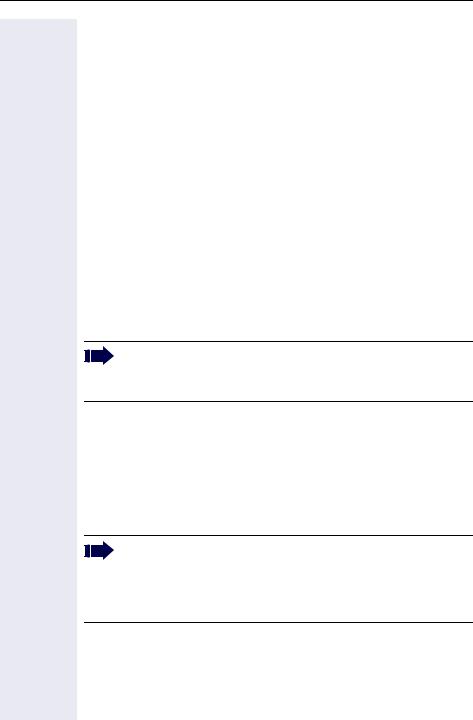
General information
General information
About this manual
This document contains general descriptions of the technical options, which may not always be available in individual cases. The respective features must therefore be individually defined in the terms of the contract.
If a particular function on your phone is not available to you, this may be due to one of the following reasons:
•The function is not configured for you or your telephone. Please contact your system support representative.
•Your communications platform does not feature this function. Please contact your Siemens sales partner for information on how to upgrade.
This user guide is intended to help you familiarize yourself with OpenStage and all of its functions. It contains important information on the safe and proper operation of your OpenStage phone. These instructions should be strictly complied with to avoid operating errors and ensure optimum use of your multifunctional telephone in the network.
These instructions should be read and followed by every person installing, operating or programming an OpenStage phone.
For your own protection, please read the section dealing with safety in detail. Follow the safety instructions carefully in order to avoid endangering yourself or other persons and to prevent damage to the unit.
This user guide is designed to be simple and easy to understand, providing clear step-by-step instructions for operating your OpenStage phone.
Administrative tasks are dealt with in a separate manual. The Quick Reference Guide contains quick and reliable explanations of frequently used functions.
Service
The Siemens service department can only help you if you experience problems or defects with the phone.
Should you have any questions regarding operation, your specialist retailer or network administrator will gladly help you.
For queries regarding connection of the telephone, please contact your network provider.
If you experience problems or defects with the phone, please dial the service number for your country.
8

General information
Intended use
The OpenStage phone is a desktop or wall-mounted unit designed for speech transmission and for connection to the LAN. Any other use is regarded as unauthorized.
Telephone type
The identification details (exact product designation and serial number) of your telephone can be found on the nameplate on the underside of the base unit. Specific details concerning your communications platform can be obtained from your service technician.
Please have this information ready when you contact our service department regarding faults or problems with the product.
Speakerphone quality and display legibility
•To ensure good speakerphone quality, the area in front of the telephone (front right) should be kept clear.
The optimum handsfree distance is 20 inches (50 cm).
•Proceed as follows to optimize display legibility:
– Turn the phone to tilt the display. This ensures you have a frontal
view of the display while eliminating light reflexes.
– Adjust the contrast as required Æ page 90.
9
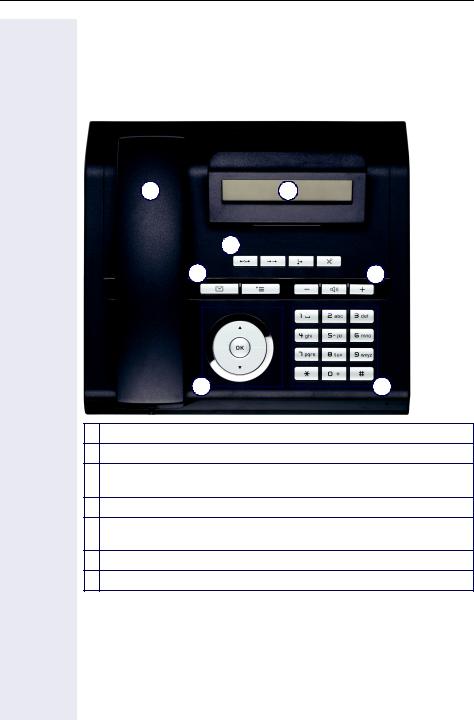
Getting to know your OpenStage phone
Getting to know your OpenStage phone
The following sections describe the most frequently used operating elements and the displays on your OpenStage phone.
OpenStage 20 user interface
1 |
|
2 |
|
|
|
||
|
|
3 |
|
|
|
|
|
4 |
|
|
|
|
5 |
||
|
|
|
|
||||
|
|
|
|
|
|
|
|
6 |
7 |
1You can make and receive calls as normal using the handset.
2The display permits intuitive operation of the phone Æ page 16.
3The function keys allow you to call up the most frequently used functions during a call (e.g. Disconnect) Æ page 13.
4Omailbox key and Nmenu key.
5Audio keys are also available, allowing you to optimally configure the audio features on your telephone Æ page 13.
6The 3-way navigator is a convenient navigation tool Æ page 14.
7The keypad is provided for input of phone numbers/codes.
10
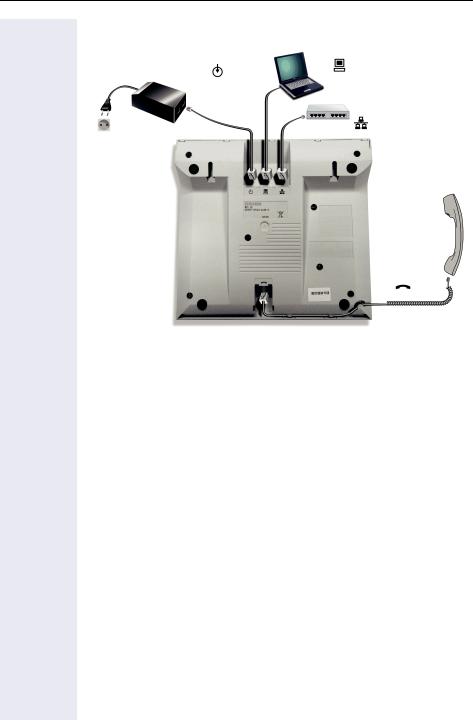
Getting to know your OpenStage phone
Ports on the underside of the phone
Power supply unit |
|
PC |
|
|
|
||
|
|
|
Network
Handset
OpenStage 20 properties
Display type |
LCD, 24 x 2 characters |
|
|
Full-duplex speakerphone function |
; |
10/100 Mbps Ethernet switch Æ page 12 |
; |
Wall mounting |
; |
11
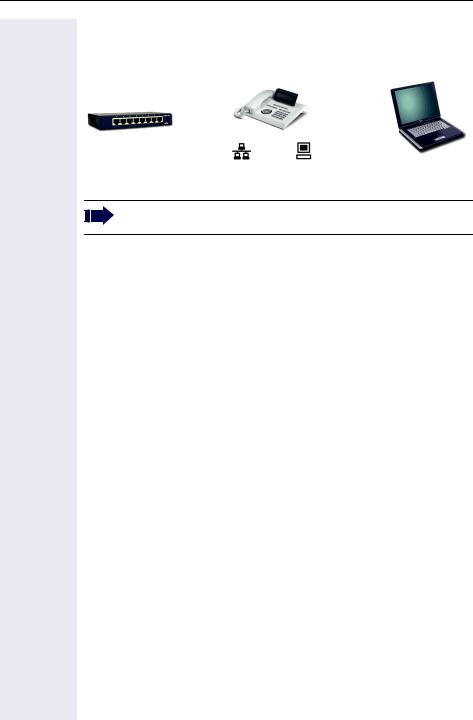
Getting to know your OpenStage phone
Using network ports more efficiently
OpenStage 20 has a built-in 10/100 Mbps Ethernet switch. This means that you can connect a PC to the LAN directly via the phone.
|
|
|
|
|
|
|
|
|
|
|
|
|
|
|
|
|
|
|
|
|
|
|
|
|
|
|
|
|
|
|
|
|
|
|
Network switch |
OpenStage 20 |
PC |
||||
To connect OpenStage 20 to a PC, you require only a commercial network cable (uncrossed).
Using this connection option saves one network port for each switch used and requires fewer or shorter network cables when arranged correctly.
12
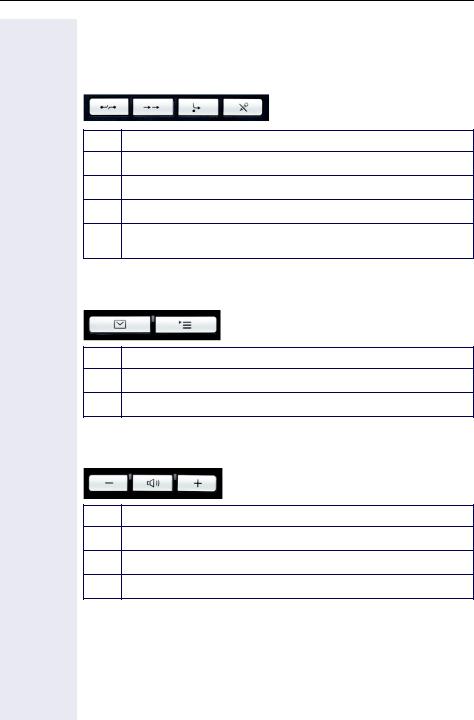
Getting to know your OpenStage phone
Keys
Function keys
Key Function when key is pressed
s End (disconnect) call Æ page 24.
, Redialing Æ page 24.
r Button for fixed call forwarding (with red LED key) Æ page 28.
pActivate/deactivate microphone (also for speakerphone mode) Æ page 25.
Mailbox key and Menu key
Key Function when key is pressed
O Open mailbox (with red LED key) Æ page 17.
N Open Program/Service menu (with red LED key) Æ page 19.
Audio keys
Key Function when key is pressed
- Reduce volume and set contrast brighter Æ page 90.
n Turn speaker on/off (with red LED key) Æ page 21.
+ Increase volume and set contrast darker Æ page 90.
13
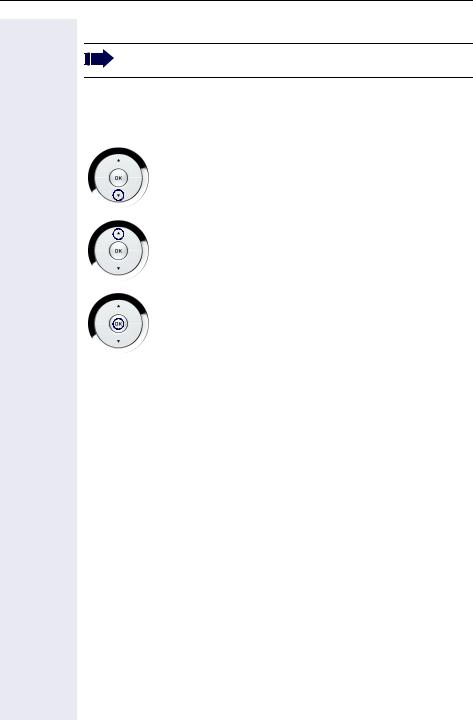
Getting to know your OpenStage phone
3-way navigator
Remove the protective film from the ring around the 3-way navigator before using the phone.
With this control, you can manage most of your phone’s functions, as well as its displays.
Operation |
Functions when key is pressed |
|
|
|
|
|
In idle mode: |
|
Press the $key. |
• |
Open the idle menu Æ page 16 |
|
In lists and menus: |
|
|
• |
Scroll down |
|
|
|
|
In idle mode: |
|
Press the %key. |
• |
Open the idle menu Æ page 16 |
|
In lists and menus: |
|
|
• |
Scroll up |
|
|
|
|
Entry selected: |
|
Press the ikey. |
• |
Perform action |
|
|
|
14

Getting to know your OpenStage phone
Keypad
In cases where text input is possible, you can use the keypad to input text, punctuation and special characters in addition to the digits 0 to 9 and the hash and asterisk symbols. To do this, press the numerical keys repeatedly.
Example: To enter the letter "h", press the number 4key on the keypad twice. When entering the text, all available characters for this key are displayed. After a short while, the character in focus is displayed in the input field.
Alphabetic labeling of dial keys is useful when entering vanity numbers (letters associated with the phone number’s digits as indicated on the telephone spell a name; e.g. 0700 - PATTERN = 0700 - 7288376).
Character overview
Key |
1x |
2x |
3x |
4x |
5x |
|
|
|
|
|
|
1 |
[1] |
1 |
|
|
|
2 |
a |
b |
c |
2 |
|
3 |
d |
e |
f |
3 |
|
4 |
g |
h |
i |
4 |
|
5 |
j |
k |
l |
5 |
|
6 |
m |
n |
o |
6 |
|
7 |
p |
q |
r |
s |
7 |
8 |
t |
u |
v |
8 |
|
9 |
w |
x |
y |
z |
9 |
0 |
+ |
. |
- |
0 |
|
) |
[2] |
|
|
|
|
( |
[3] |
|
|
|
|
[1]Space
[2]Next letter in upper case
[3]Delete character
Text input
Enter the required characters via the keypad.
Select the functions using the keys %and $.
Confirm your entry with i.
15

Getting to know your OpenStage phone
Display
Your OpenStage 20 comes with a tilt-and-swivel black-and-white LCD display. Adjust the tilt and contrast to suit your needs Æ page 90.
Idle mode
Your phone is in idle mode when there are no calls taking place or settings being made.
Example: |
|
|
|
|
|
|
||
|
|
|
|
|
|
|
|
Time |
|
|
|
|
|
|
|
||
|
|
|
|
|
|
|
|
|
|
|
|
|
|
|
|
|
|
|
13:15 |
MON 02.03.07 |
|
|
|
Date |
||
|
|
|
|
|||||
|
220870 |
f |
|
|
|
|||
|
|
|
|
|
|
|
|
Open the idle menu |
|
|
|
|
|
|
|
|
|
|
|
|
|
|
|
|
|
Own phone number |
|
|
|
|
|
|
|
|
|
Idle menu
When in idle mode, press a key on the 3-way navigator Æ page 14 to display the idle menu. You can call up various functions here. The idle menu includes selected functions from the Program/Service menu Æ page 19.
It may contain the following entries:
•Caller list
•Forwarding on
•Lock phone
•DND on[1]
•Advisory msg. on
•Ringer cutoff on
•Send message
•View callbacks[2]
•Directory
•HF answerback on
•Suppress call ID
•Waiting tone off
•DISA intern
[1]Must be activated by service personnel.
[2]Only appears if callback requests are saved
16
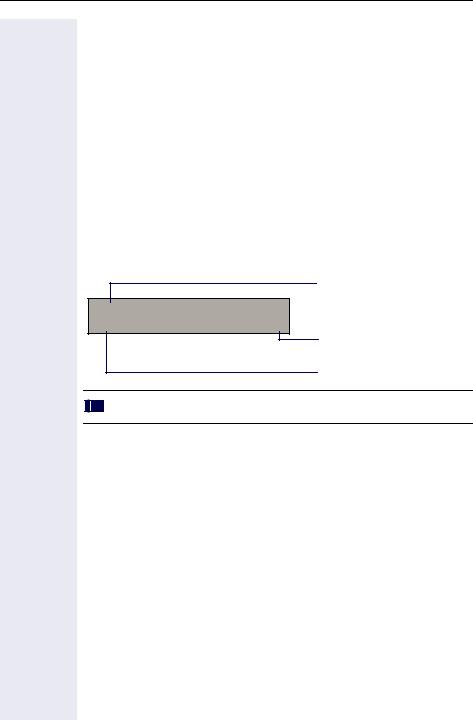
Getting to know your OpenStage phone
Mailbox
Depending on the type and configuration of your communications platform (contact the relevant service personnel), messages from services, such as HiPath Xpressions are displayed in this application in addition to messages received.
Messages
You can send short text messages to individual internal stations or groups.
In idle mode (Æ page 16) the following signals alert you to the presence of new messages:
•Okey LED lights up
•Displays "Messages received".
Press the mailbox key O.
Example:
Caller ID
Msg. from: Coco, Chanel |
f |
Message sent? |
Function menu
Display message
 For a description of how to edit the entries Æ page 68.
For a description of how to edit the entries Æ page 68.
Voicemail
If your telephone is connected to a voicemail system (such as Entry Voice Mail), the Mailbox key will also light up to alert you to any messages that have arrived.
An appropriate message also appears on the display (for instance, in Entry Voice Mail: "X new messages").
To play back your voicemails, follow the instructions on the display.
17
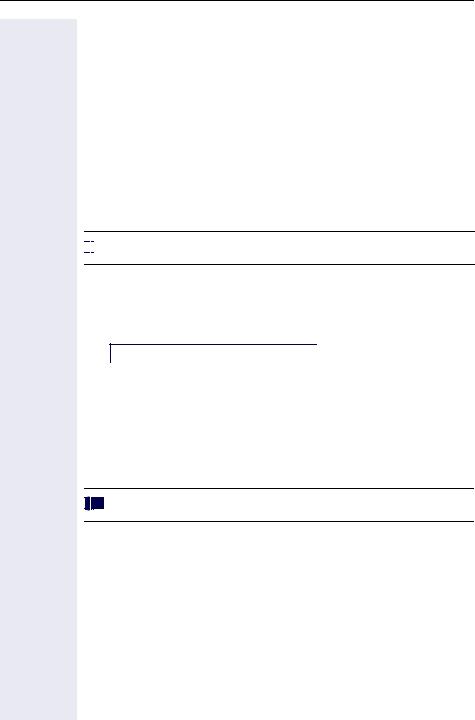
Getting to know your OpenStage phone
Caller list
If you are unable to accept an external or internal call, the call attempt is stored in the caller list.
You can store answered calls either manually (both internal and external calls) or automatically (external calls only; contact your service personnel for details).
Your telephone stores up to ten calls in chronological order. Each call is assigned a time stamp. The most recent entry not yet answered in the list is displayed first. Multiple calls from the same caller do not automatically generate new entries in the caller list. Instead, only the most recent time stamp for this caller is updated and its number incremented.
The caller list is automatically displayed Æ page 16 in the idle menu Æ page 39.






 Callers with suppressed numbers cannot be saved in the call log.
Callers with suppressed numbers cannot be saved in the call log.
Information is displayed regarding the caller and the time at which the call was placed.
Example:
Caller ID
10168 PETER |
|
|
16:25 f |
|
|
|
|
|||
Busy |
21.02. |
|
|
|
Function menu |
|||||
|
|
|
|
|
|
|
|
|
|
|
|
|
|
|
|
|
|
|
|
|
|
|
|
|
|
|
|
|
|
|
|
Time |
|
|
|
|
|
|
|
|
|
||
|
|
|
|
|
|
|
|
|
|
Date |
|
|
|
|
|
|
|
|
|
||
|
|
|
|
|
|
|
|
|
|
Telephone status during |
|
|
|
|
|
|
|
|
|
||
|
|
|
|
|
|
|
|
|
|
a call attempt |
 For a description of how to edit the call logs Æ page 39.
For a description of how to edit the call logs Æ page 39.
18
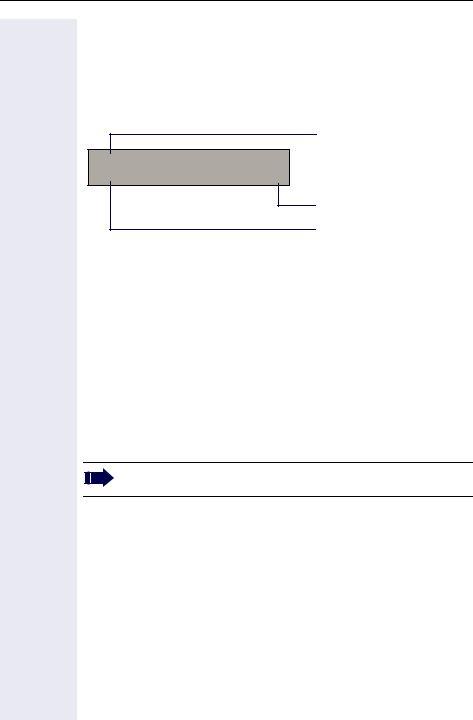
Getting to know your OpenStage phone
Program/Service menu
Use the Nmenu key to reach your communication system’s Program/ Service menu.
The menu key LED remains red as long as you are in this menu.
Example:
Menu title
Program/Service: |
f |
*7=Use speed dialing? |
Further entries are available
Menu option
The menu structure comprises several levels. The first line in this structure shows the menu currently selected while the second line shows an option from this menu. A double arrow next to an entry indicates the availability of additional options for this entry.
Accessing the menu
There are three ways to open the Program/Service menu on your communication system:
1.Press the menu key N. Use the $or %keys to select an option and confirm with the ikey.
2.Press $or %and select a function from the idle menu Æ page 16.
3.In idle mode, press (or )and the code for the function you want.
For an overview of the maximum functions available, with corresponding codes, see Æ page 101.
19

Basic functions
Step by Step
Basic functions
Please read the introductory chapter "Getting to know your OpenStage phone" Æ page 10 carefully before performing any of the steps described here on your phone.
Answering a call
Special default ring signaling is set for your telephone:
•When you receive an internal call, your telephone rings once every four seconds (single-tone sequence).
•When you receive an external call, your telephone rings twice in rapid succession every four seconds (dual-tone sequence).
•When you receive a call from the entrance telephone, your telephone rings three times in rapid succession every four seconds (triple-tone sequence).
•If a call is waiting, you hear a short tone (beep) every six seconds.
Your service personnel can adjust the ring cadence for external and internal calls for you. In other words, different ring cadences can be set for different internal callers.
The number or the name of the caller appears on the display.
Answering a call via the handset
The phone is ringing. The caller appears on the screen.
^Lift the handset.
+or - Raise or lower the volume. Keep pressing the key until
the desired volume is set.
20

Basic functions
Step by Step
Answering a call via the loudspeaker (speakerphone mode)
Suggestions for using speakerphone mode:
•Tell the other party that you are using speakerphone mode.
•The speakerphone works bests at a low receiving volume.
•The ideal distance between the user and the telephone set in speakerphone mode is about 50 cm (approx. 20 inches).
The phone is ringing. The caller appears on the screen. n Press the key shown. The LED lights up.
if nec. +or - Raise or lower the volume. Keep pressing the key until the desired volume is set.
Ending a call
n Press the key shown. The LED goes out. or
s Press the key shown.
Switching to speakerphone mode
Prerequisite: You are conducting a call via the handset.
n\ Hold down the key and replace the handset. Then release the key.
if nec. +or - Set the call volume. Keep pressing the key until the desired volume is set.
U.S. mode
If the country setting is set to U.S. (ask the service personnel), you do not have to hold down the loudspeaker key when replacing the handset to switch to speakerphone mode.
n Press the key shown.
] Replace the handset. Proceed with your call.
if nec. +or - Set the call volume. Keep pressing the key until the desired volume is set.
21

Basic functions
Step by Step
Switching to the handset
Prerequisite: You are engaged in a call in speakerphone mode.
^and [ Lift the handset. Proceed with your call.
Open listening in the room during a call
You can let other people in the room join in on the call. Let the other party know that you have turned on the speaker.
Prerequisite: You are conducting a call via the handset.
Activating
n Press the key shown. The LED lights up.
Deactivating
n Press the key shown. The LED goes out.
22

Basic functions
Step by Step
Making calls
Off-hook dialing
^ Lift the handset.
jInternal calls: Enter the station number.
External calls: Enter the external code and the station number.
The called party does not answer or is busy:
\Replace the handset.
On-hook dialing
jInternal calls: Enter the station number.
External calls: Enter the external code and the station number.
The other party answers with speaker:
^Lift the handset.
or On-hook dialing: Speakerphone mode.
The called party does not answer or is busy: n Press the key shown. The LED goes out.
23
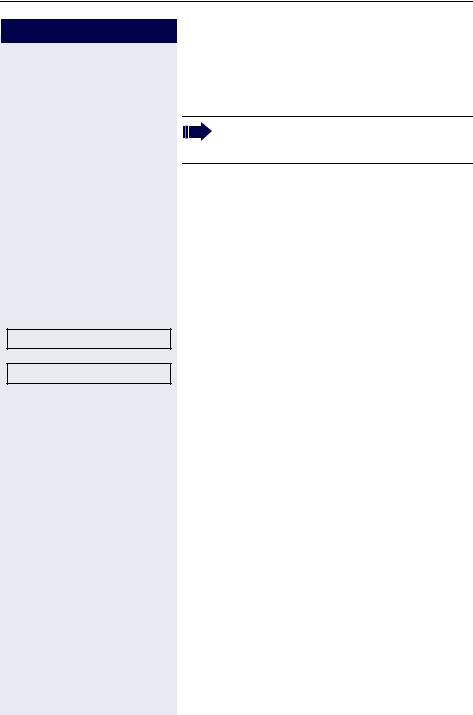
Basic functions
Step by Step
Next?
Call?
,
or
\
or s
Redialing a number
The last three external telephone numbers dialed are stored automatically.
If this feature is configured (contact your service personnel), account codes entered are also saved Æ page 58.
You can redial them simply by pressing a key.
Displaying and dialing saved station numbers
Press the key once to dial the number last dialed.
Press the key twice to dial the next to the last number dialed.
Press the key three times to dial the third-to-the-last number dialed.
Keep confirming until the phone number you want appears.
Select and confirm the option shown.
Ending a call
Replace the handset.
Press the key shown.
24

Basic functions
Step by Step
Rejecting calls
You can reject calls which you do not wish to take. The call is then signaled at another definable telephone (contact your service personnel).
The phone is ringing. The caller appears on the screen.
sPress the key shown.
If a call cannot be rejected, your telephone will continue to ring. The message "Currently not possible" is displayed (e.g. in the case of recalls).
Turning the microphone on and off
To prevent the other party from listening in while you consult with someone in your office, you can temporarily switch off the handset microphone or the handsfree microphone. You can also switch on the handsfree microphone to answer an announcement via the telephone speaker (speaker call, Æ page 35).
Prerequisite: A connection is set up, the microphone is activated.
p Press the key shown. The LED lights up.
or
p Press the lit key. The LED goes out.
25
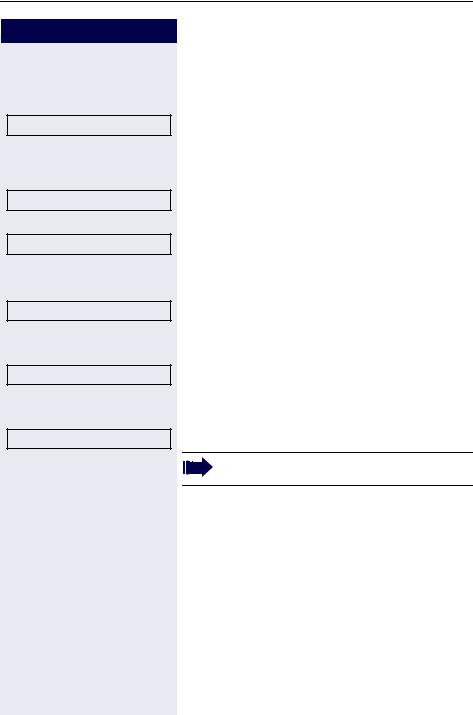
Basic functions
Step by Step
Consultation?
Return to held call?
Quit and return?
Toggle/Connect?
Conference?
Leave conference?
Calling a second party (consultation)
You can call a second party while a call is in progress. The first party is placed on hold.
Confirm.
jCall the second party.
Return to the first party:
Confirm,
or
select and confirm the option shown.
Switching to the held party (alternating)
Select and confirm the option shown.
Combine the calling parties into a three-party conference
Select and confirm the option shown.
Allowing call partners to continue a conference after you exit
Select and confirm the option shown.
For more information on conferences, see Æ page 50.
26
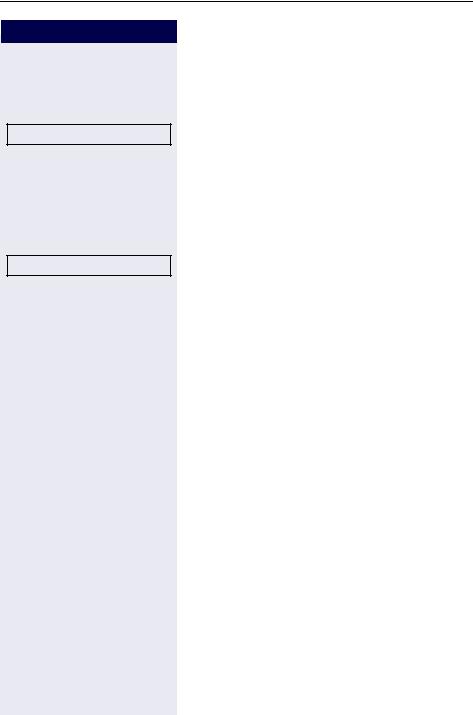
Basic functions
Step by Step
Consultation?
Transfer?
j
[
\
or
Transferring a call
If the person you are speaking to wants to talk to another colleague of yours, you can transfer the call that colleague.
Confirm.
Enter the number of the party to which you want to transfer the call.
Announce the call, if necessary.
Replace the handset.
Select and confirm the option shown.
27
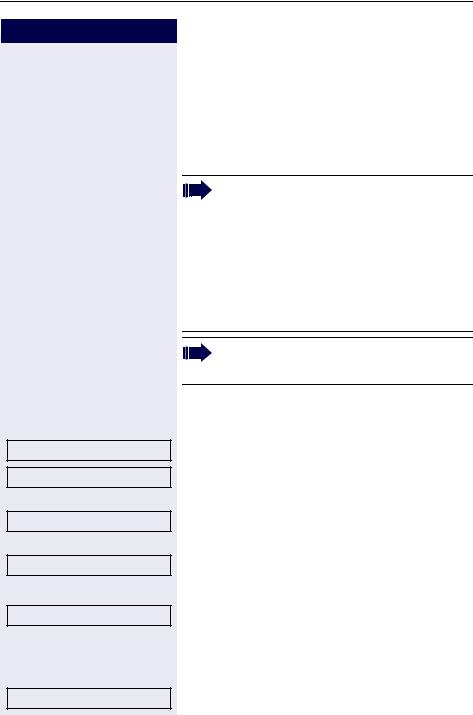
Basic functions
Step by Step
r
or
$
Forwarding on?
1=all calls?
or
2=external calls only?
or
3=internal calls only?
j
Save?
r or
Forwarding off
Call forwarding
Using variable call forwarding
You can immediately forward internal or external calls to different internal or external telephones (destinations). (External destinations require special configuration in the system.)
When call forwarding is active, a special dial tone sounds when you lift the handset.
If DID DTMF is active (contact your service personnel), you can also forward calls to this destination. Destinations: fax = 870, DID = 871,
fax DID = 872.
If you are a call forwarding destination, your display will show the station number or the name of the originator on the upper line and that of the caller on the lower line.
Special features must be taken into consideration if your telephone operates with HiPath 5000 (system networking via PC network) Æ page 85!
Press the key shown.
Open the idle menu Æ page 16.
Select and confirm the option shown.
Confirm,
select and confirm the option shown,
select and confirm the option shown.
Enter the number of the telephone that is ringing.
Confirm.
Deactivating call forwarding
Press the key shown.
Select and confirm the option shown.
28
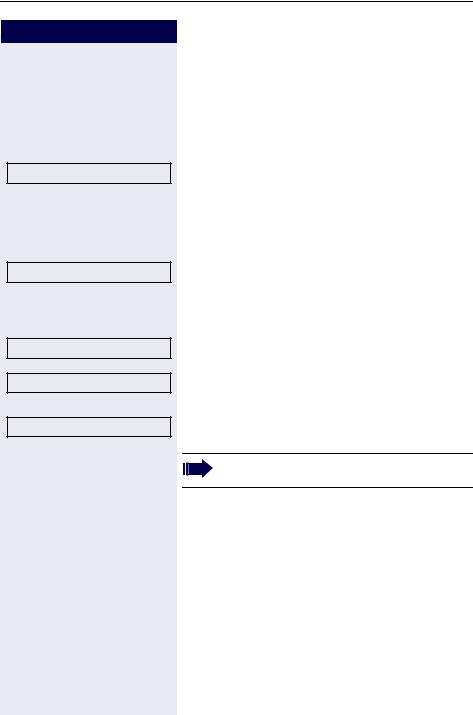
Basic functions
Step by Step
N
*495=CFNR on?
j
Save?
N
#495=CFNR off?
Delete?
or
Exit
Using call forwarding no reply (CFNR)
Calls that are not answered after three rings (=default, can be adjusted by service personnel) or that are received while another call is ongoing can be automatically forwarded to a specified telephone.
Press the key shown.
Select and confirm the option shown.
Enter the destination number.
•Enter the internal station number for internal destinations
•Enter the external code and the external station number for external destinations
Confirm.
Deactivating Call Forwarding No Reply
Press the key shown.
Select and confirm the option shown.
Confirm.
Select and confirm to deactivate but not delete the forwarding destination.
If CFNR is activated, when you hang up, "CFNR: " appears briefly on the display.
29
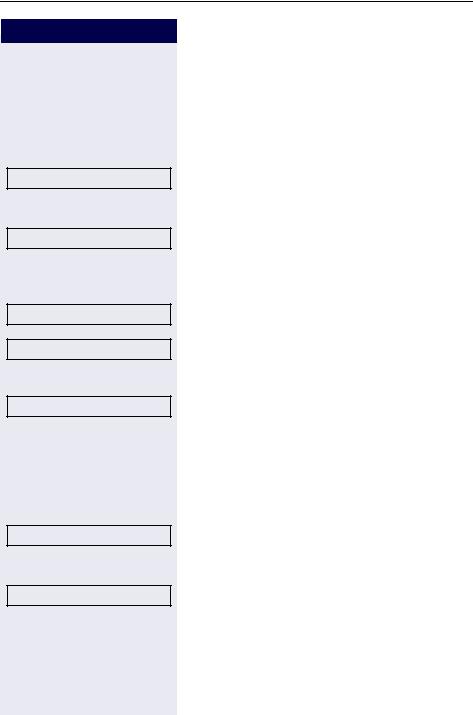
Basic functions
Step by Step
N
*9411= CFSS on?
j
Save?
N
#9411= CFSS off?
Delete?
or
Exit?
N )9411
Change?
j
Save?
Call forwarding in the event of telephone failure (CFSS)
If configured (consult your service personnel), you can define an internal or external call forwarding destination that activates in the event of telephone failure.
Press the key shown.
Select and confirm the option shown.
Enter the number of the telephone that is ringing.
Confirm.
Deactivating call forwarding/deleting a destination:
Press the key shown.
Select and confirm the option shown.
Confirm the option shown to deactivate and delete the forwarding destination.
Select and confirm to deactivate but not delete the forwarding destination.
Changing the forwarding destination (if call forwarding is active):
Press the key shown.
Enter the code.
Confirm.
Change the destination phone number.
Confirm.
30
